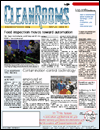Table of Contents
Solid State Technology
Year 2001
Issue 11
 | NEWS
Particles
Particles
Trials for E.coli vaccine; Shipley awarded Low-K dielectric patent; Owens opens cleanroom...
News
Finally, a little good news
According to the September 2001 update to IC Insight's (Scottsdale, AZ) McClean Report, the integrated circuit (IC) recovery of 2001 (Fig. 2) will most certainly mirror that "canoe" shape, or rolling bottom...
News
BOC aims to increase the brightness of LEDs
Wilmington, MA—BOC Edwards has developed an ammonia gas production system that removes impurities for use in the manufacturing of light emitting diodes (LEDs).
News
Donaldson applies cleanroom filter technology to fuel cells
MINNEAPOLIS—Donaldson Co. Inc., a leader in filtration systems serving a variety of industries including the cleanroom market, announced in September the first airborne contaminant and noise filtration systems developed especially for use with fuel cells.
News
Connectivity: The next great aid in 300-mm contamination control?
SAN JOSE, CA—As the semiconductor industry moves to increase wafers to 300 mm and shrink geometries below 0.10 micron, many fab owners are faced with the challenge of decreasing the amount of contamination on the processed wafer.
News
Food inspection moves toward automation
SEBASTIAN, FL—When it comes to fecal contamination on cattle carcasses, the U.S. Department of Agriculture (USDA) mandates that any is too much.
News
Fungal contamination prompts diabetes treatment recall
Kalamazoo, MI—Pharmacia Corp. has voluntarily recalled three lots of its diabetic treatment, Micronase, after in-house tests on three separate strengths of tablets revealed fungal contamination.
News
FDA approves first nucleic acid test
Rockville, MD—The U.S. Food and Drug Administration (FDA) has approved the first nucleic acid test (NAT) systems for screening donor plasma, a landmark move that aims at ensuring the safety of blood protein-derived products by providing faster detection of HIV- and hepatitis C- viruses.
News
Contamination control technology employed at Ground Zero
NEW YORK—Shortly after rescue crews stormed Ground Zero, state, local and federal agencies deployed contamination control technology to monitor and clean up the disaster left in the wake of debris-filled leviathans that were unleashed by the collapsing of the World Trade Center towers.
|
|
DEPARTMENTS
Viewpoint
You were there
The story, suggested by one of our sales reps, is about our contamination control brethren, who, along with regards of hope and empathy, quietly donated money and products to aid rescue and clean up efforts following the most horrific acts of terrorism to date.
Letters
Forward-thinking approaches
I read the point of view offered by Richard Matthews in the "Unfiltered" column (CleanRooms, September, 2001) with significant interest since Mr. Matthews is both highly regarded in the professional arena and because the topic of contamination control is one that I feel is relevant in the evolving compliance issues that exist today within the pharmaceutical industry.
Inventors Corner
Inventor's Corner
Disposable mask and suction catheter; Induction assembly; Air purifier...
Unfiltered
There's no time like the present to prepare
The recent tragedy at the World Trade Center in New York powerfully illustrates how an entire country can be caught off guard by an unexpected disaster. Disasters are personal; they affect people in ways you can't imagine.
Viewpoint
An ounce of prevention
No matter how much we plan for any situation, we almost always end up blindsided by what actually unfolds in front of us. We know that a fail-safe preparation plan for disaster simply doesn't exist.
| |
FEATURES
Built To Spec
Start-up aims to revolutionize print with electronic ink
Hybrid chipmaker E Ink Corp. (Cambridge, MA) believes ordinary paper may become a thing of the past now that the start-up has begun developing flexible transistors for its electronic ink displays in a recently completed facility in nearby Woburn, MA.
Special Report
The Web finds its way
Just one year ago, cleanroom suppliers and distributors were approaching the Web cautiously, using it primarily for information dissemination and sales of catalog-type consumables. But today, caution is giving way to full acceptance. Convinced that the Web is an important link in the cleanroom supply chain, vendors and distributors are working to expand their Web operations.
Features
VHP takes its place in room decontamination
Avariety of methods and antimicrobial agents have been used for the periodic decontamination of critical environments. Conventional wipe down techniques with antimicrobial products can be time consuming and labor intensive, while traditional fumigation with formaldehyde is slow and carries safety concerns.
| |
COLUMNS
Electronics
Non-filtration, particle-fluid separations
The physical, particle-fluid separations described last month convert an initial particle-fluid mixture, or flow stream, into two or more particle-fluid mixtures or output streams. At least one of those output streams has higher particle concentration than the feed stream and at least one has lower particle concentration.
Life Sciences
Mislabled raw material containers are the ultimate contamination-control mystery
Feeling lucky? This could be the motto for employees working in the incoming sampling area at a pharmaceutical manufacturer. This receiving area is the entry point for raw materials in the facility and is the first place individuals will come into contact with the hazardous potent substances used in the pharmaceutical production process.
| |
PRODUCTS
Product Comparator
Keeping ahead of particles
Simply put, particle counters are used for certifying cleanrooms and cleanroom devices. Detecting and reducing particle contamination are critical concerns in many industries. In fact, particle contamination is believed to be responsible for more than 80 percent of the product yield loss in the semiconductor industry.
New Products
New Products
Charged plate monitor; Water pump; In-room air purifier; Wiper...
| |
|